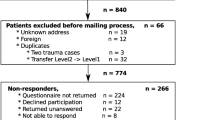Abstract
Background
Following trauma, the number of preventable deaths is low. Outcome should also be measured in terms of quality of life (QoL). Studies analyzing QoL in trauma patients have been published, but little is known about the long term QoL of victims of terrorist attacks.
Methods
This is a case–control study of casualties of the March 11, 2004 attacks in Madrid. Patients treated for other trauma with similar age and Injury Severity Score (ISS), served as controls. Patients were assessed using the POLO-Chart (VAS, SF-36 and TOP).
Results
Fifty-eight patients were included, 32 casualties admitted following the March 11, 2004 attacks and 26 controls. Both groups were comparable in age (average = 37), ISS (average = 23) and time from trauma (average = 1,770 days). Subjects demonstrated lower scores for the VAS, and the SF-36 clusters social functioning, role emotional and mental health. There was a tendency towards higher prevalence of symptoms associated to posttraumatic stress disorder (PTSD) in subjects (p = 0.056). Subjects suffered from higher residual pain in the head region (p = 0.032). Strong association was found between the presence of symptoms associated to depression, anxiety and PTSD and worse QoL (p < 0.001).
Conclusion
Subjects present more emotional distortions, residual pain in the head region and a tendency towards a worsened perception of their own health and wellness. They also present symptoms associated to PTSD more frequently. The presence of symptoms associated to PTSD, depression or anxiety was an independent variable related to lower QoL in both groups.


Similar content being viewed by others
References
Cameron PA, Gabbe BJ, McNeil JJ. The importance of quality of survival as an outcome measure for an integrated trauma system. Injury. 2006;37(12):1178–84.
Neugebauer E, Bouillon B, Bullinger M, Wood-Dauphinée S. Quality of life after multiple trauma—summary and recommendations of the consensus conference. Restor Neurol Neurosci. 2002;20(3–4):161–7.
Pirente N, Ottlik Y, Lefering R, Bouillon B, Neugebauer E, The Working Group “Polytrauma” of the DGU. Quality of life in multiply injured patients development of the trauma outcome profile (TOP) as part of the Modular Polytrauma Outcome (Polo) Chart. Eur J Trauma. 2006;32(1):44–62.
Vilagut G, Ferrer M, Rajmil L, Rebollo P, Permanyer-Miralda G, Quintana JM, et al. The Spanish version of the Short Form 36 Health Survey: a decade of experience and new developments. Gac Sanit. 2005;19(2):135–50.
Alonso J, Regidor E, Barrio G, Prieto L, Rodríguez C, de la Fuente L. Population-based reference values for the Spanish version of the Health Survey SF-36. Med Clin (Barc). 1998;111(11):410–6.
Neugebauer E, Lefering R, Bouillon B, Bullinger M, Wood-Dauphinee S. Quality of life after multiple trauma. Aim and scope of the conference. Restor Neurol Neurosci. 2002;20(3-4):87–92.
Pirente N, Bouillon B, Schäfer B, Raum M, Helling HJ, Berger E, et al. Systematic development of a scale for determination of health-related quality of life in multiple trauma patients. The Polytrauma Outcome (POLO) Chart. Unfallchirurg. 2002;105(5):413–22.
Gudmundsdottir B, Beck JG, Coffey SF, Miller L, Palyo SA. Quality of life and post trauma symptomatology in motor vehicle accident survivors: the mediating effects of depression and anxiety. Depress Anxiety. 2004;20(4):187–9.
O’Donnell ML, Creamer M, Elliott P, Atkin C, Kossmann T. Determinants of quality of life and role-related disability after injury: impact of acute psychological responses. J Trauma. 2005 59(6):1328–34 (discussion 1334−1335).
Kiely JM, Brasel KJ, Weidner KL, Guse CE, Weigelt JA. Predicting quality of life six months after traumatic injury. J Trauma. 2006;61(4):791–8.
Johansen VA, Wahl AK, Eilertsen DE, Weisaeth L, Hanestad BR. The predictive value of post-traumatic stress disorder symptoms for quality of life: a longitudinal study of physically injured victims of non-domestic violence. Health Qual Life Outcomes. 2007;5:26.
Holbrook TL, Hoyt DB, Stein MB, Sieber WJ. Perceived threat to life predicts posttraumatic stress disorder after major trauma: risk factors and functional outcome. J Trauma. 2001 51(2):287–92 (discussion 292–293).
Holbrook TL, Hoyt DB, Stein MB, Sieber WJ. Gender differences in long-term posttraumatic stress disorder outcomes after major trauma: women are at higher risk of adverse outcomes than men. J Trauma. 2002;53(5):882–8.
Holbrook TL, Hoyt DB, Coimbra R, Potenza B, Sise M, Anderson JP. Long-term posttraumatic stress disorder persists after major trauma in adolescents: new data on risk factors and functional outcome. J Trauma. 2005 58(4):764–9 (discussion 769–771).
Holbrook TL, Hoyt DB, Coimbra R, Potenza B, Sise MJ, Sack DI, et al. Trauma in adolescents causes long-term marked deficits in quality of life: adolescent children do not recover preinjury quality of life or function up to two years postinjury compared to national norms. J Trauma. 2007 62(3):577–83 (discussion 583).
Pirente N, Blum C, Wortberg S, Bostanci S, Berger E, Lefering R, et al. Quality of life after multiple trauma: the effect of early onset psychotherapy on quality of life in trauma patients. Langenbecks Arch Surg. 2007;392(6):739–45.
Conflict of interest statement
None.
Author information
Authors and Affiliations
Corresponding author
Rights and permissions
About this article
Cite this article
Serralta-Colsa, D., Camarero-Mulas, C., García-Marín, A.M. et al. Functional outcome and quality of life in victims of terrorist explosions as compared to conventional trauma. Eur J Trauma Emerg Surg 37, 31–36 (2011). https://doi.org/10.1007/s00068-010-0020-2
Received:
Accepted:
Published:
Issue Date:
DOI: https://doi.org/10.1007/s00068-010-0020-2




